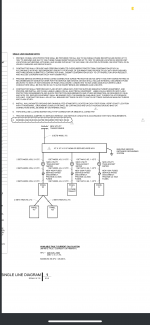As others have noted, running one run in conduit A and two parallel runs in conduit B is not kosher for _parallel_ conductors. I'm just going to look at the derating question.
You ask 'How would I go about derating' in this abnormal situation of trying to parallel conductors with different ampacity.
IMHO: If you have conductors of different ampacity in parallel, you would need to adjust the total ampacity to ensure that no single conductor gets overloaded. Again, for normal NEC parallel conductor installations this is simply prohibited.
Consider the OP's scenario where you have conductors of the same size but in different temperature conditions (the 2 sets in one conduit will run hotter than 1 set in one conduit). The impedance of the conductors will be very nearly equal, and thus the current will divide evenly between all three sets. This tells me that the ampacity of the single set ends up limited by the derating of the paired set to ensure that the conductors in the paired set don't carry too much current. So in this case simply figure out the derating factor for the 2 sets in one conduit, then apply that derating factor to all 3 sets.
As far as a practical solution to this situation, I like the approach of simply running two sets of 350 in each conduit, but this might hit problems on the ends with too many terminations for the various device terminals. If you are in one of the rare circumstances where the neutral counts as a CCC you might need to bump up to 2 sets of 400 in each conduit. If you try to replace 3 parallel 350s with 2 parallel larger conductors, you bump into the fact that larger conductors need greater conductor cross section per amp, and you need more copper cross section for the same current.
-Jon



